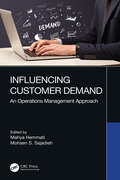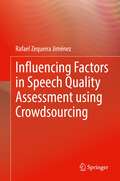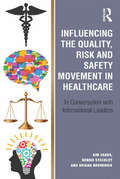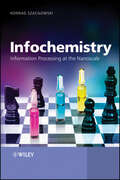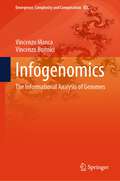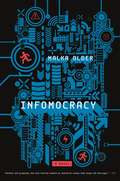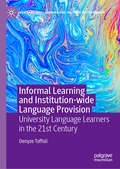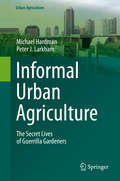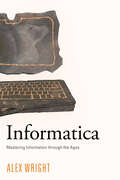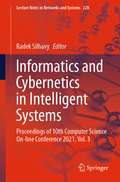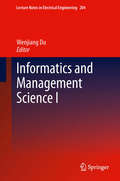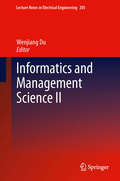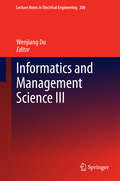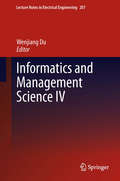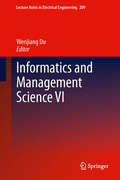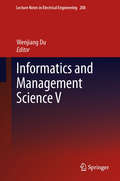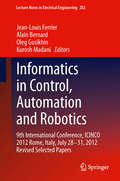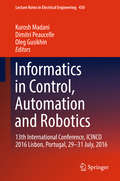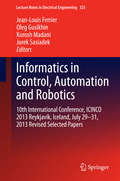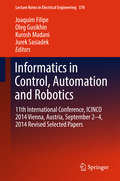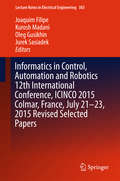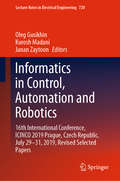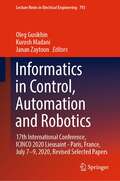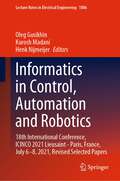- Table View
- List View
Influencing Customer Demand: An Operations Management Approach
by Mahya Hemmati Mohsen S. SajadiehIn today’s competitive markets, considering the demand and the supply chain sides is crucial to keeping revenue and customer satisfaction maximized. Managing and planning demand play a vital role in the sustainability of a company. This is the first book to the discuss managerial, mathematical, and conceptual framework of influencing factors on demand along with accurate mathematical analyses to evaluate and raise revenue. The book provides an understanding of the key elements that impact buyer demand. It presents the mathematical relationship between the influencing factors and the demand functions. It discusses the methods used for inspiring demand, how to measure demand dependency on components such as price, quality, and inventory, and it helps management improve alignment between supply and demand by affecting the level and understanding of the role within supply chain management (SCM). This book is applicable for the professional as well as for academia. It can help those working in SCM, project management, production, inventory control, scheduling, engineering management, retail management, and operations management.
Influencing Factors in Speech Quality Assessment using Crowdsourcing
by Rafael Zequeira JiménezThis book evaluates the impact of relevant factors affecting the results of speech quality assessment studies carried out in crowdsourcing. The author describes how these factors relate to the test structure, the effect of environmental background noise, and the influence of language differences. He details multiple user-centered studies that have been conducted to derive guidelines for reliable collection of speech quality scores in crowdsourcing. Specifically, different questions are addressed such as the optimal number of speech samples to include in a listening task, the influence of the environmental background noise in the speech quality ratings, as well as methods for classifying background noise from web audio recordings, or the impact of language proficiency in the user perception of speech quality. Ultimately, the results of these studies contributed to the definition of the ITU-T Recommendation P.808 that defines the guidelines to conduct speech quality studies in crowdsourcing.
Influencing the Quality, Risk and Safety Movement in Healthcare: In Conversation with International Leaders
by Kim Sears Denise StockleyInfluencing the Quality, Risk and Safety Movement in Healthcare explores the inner workings of some of the most influential minds in healthcare quality, risk and safety. The book was created in cooperation with the Master of Science in Healthcare Quality graduate program, developed and delivered by Queen’s University, Canada. This is the only standalone interdisciplinary Master of Science graduate degree in Healthcare Quality in North America that focuses on creating tomorrow’s healthcare leaders. Following a one-to-one collaboration between each leader in healthcare with a dedicated learner of the MSc(HQ), readers are presented with a synopsis of the leader’s work followed by an in-depth interview with him or her. Interviews center around the leaders’ contributions to and thoughts on quality, risk and safety in healthcare, dealing with topics such as the development of their body of work, their greatest achievements, what they wish they could change, and future direction of quality, risk and safety, etc. The book provides a unique and highly accessible view into how and why the science of healthcare quality has developed, as well as giving a first-hand account of the founders and key players in the movement. It will offer valuable insights to any undergraduate/graduate class with an interest in healthcare, as well as professionals working within any of the many disciplines that can influence the healthcare system.
Infochemistry
by Konrad SzacilowskiInfochemistry: Information Processing at the Nanoscale, defines a new field of science, and describes the processes, systems and devices at the interface between chemistry and information sciences. The book is devoted to the application of molecular species and nanostructures to advanced information processing. It includes the design and synthesis of suitable materials and nanostructures, their characterization, and finally applications of molecular species and nanostructures for information storage and processing purposes.Divided into twelve chapters; the first three chapters serve as an introduction to the basic concepts of digital information processing, its development, limitations and finally introduces some alternative concepts for prospective technologies. Chapters four and five discuss traditional low-dimensional metals and semiconductors and carbon nanostructures respectively, while further chapters discuss Photoelectrochemical photocurrent switching and related phenomena and self-organization and self-assembly. Chapters eight, nine and ten discuss information processing at the molecular level, and eleven describes information processing in natural systems. The book concludes with a discussion of the future prospects for the field.Further topics:Traditional electronic device development is rapidly approaching a limit, so molecular scale information processing is critical in order to meet increasing demand for high computational powerCharacterizes chemical systems not according to their chemical nature, but according to their role as prospective information technology elementsCovers the application of molecular species and nanostructures as molecular scale logic gates, switches, memories, and complex computing devicesThis book will be of particular interest to researchers in nanoelectronics, organic electronics, optoelectronics, chemistry and materials science.
Infogenomics: The Informational Analysis of Genomes (Emergence, Complexity and Computation #48)
by Vincenzo Manca Vincenzo BonniciThe book presents a conceptual and methodological basis for the mathematical and computational analysis of genomes. Genomes are containers of biological information, which direct the cell functions and the evolution of organisms. Combinatorial, probabilistic, and informational aspects are fundamental ingredients of any mathematical investigation of genomes aimed at providing mathematical principles for extracting the information that they contain. The topics presented in the book include research themes developed by authors in the last 15 years, and in many aspects, the book continues a preceding volume (Vincenzo Manca, Infobiotics: Information in biotic systems, Springer, 2013). The main inspiring idea of the book is an informational perspective to Genomics. Information is the most recent, among the fundamental mathematical and physical concepts developed in the last two centuries. It has revolutionized the whole science and continues, in this direction, to dominate the trends of the contemporary science. In fact, any discipline collects data from observations, by providing theories able to explain, predict, and dominate natural phenomena. But data are containers of information, whence information is essential in any scientific elaboration. Many open problems in deciphering genomes will be addressed, by showing an informational approach to the discovery of “genome languages”, according to which genomic texts are written. Life strategies, at many levels of organization, are encoded in these texts, and randomness has a crucial role in the birth and in the development of biological information, where the interplay of casualty and computation is probably the most secret key of life intelligence.
Infomocracy: Book One of the Centenal Cycle (The Centenal Cycle #1)
by Malka OlderRead Infomocracy, the first book in Campbell Award finalist Malka Older's groundbreaking cyberpunk political thriller series The Centenal Cycle, a finalist for the Hugo Award for Best Series, and the novel NPR called "Kinetic and gripping."• A Locus Award Finalist for Best First Novel• The book The Huffington Post called "one of the greatest literary debuts in recent history"• One of Kirkus' "Best Fiction of 2016"• One of The Washington Post's "Best Science Fiction and Fantasy of 2016"• One of Book Riot's "Best Books of 2016 So Far"It's been twenty years and two election cycles since Information, a powerful search engine monopoly, pioneered the switch from warring nation-states to global micro-democracy. The corporate coalition party Heritage has won the last two elections. With another election on the horizon, the Supermajority is in tight contention, and everything's on the line.With power comes corruption. For Ken, this is his chance to do right by the idealistic Policy1st party and get a steady job in the big leagues. For Domaine, the election represents another staging ground in his ongoing struggle against the pax democratica. For Mishima, a dangerous Information operative, the whole situation is a puzzle: how do you keep the wheels running on the biggest political experiment of all time, when so many have so much to gain?Infomocracy is Malka Older's debut novel.THE CENTENAL CYCLEBook 1: InfomocracyBook 2: Null StatesBook 3: State TectonicsPRAISE FOR INFOMOCRACY“A fast-paced, post-cyberpunk political thriller... If you always wanted to put The West Wing in a particle accelerator with Snow Crash to see what would happen, read this book.” —Max Gladstone, author of Last First Snow"Smart, ambitious, bursting with provocative extrapolations, Infomocracy is the big-data-big-ideas-techno-analytical-microdemoglobal-post-everything political thriller we've been waiting for." —Ken Liu, author of The Grace of Kings"In the mid-21st century, your biggest threat isn’t Artificial Intelligence—it’s other people. Yet the passionate, partisan, political and ultimately fallible men and women fighting for their beliefs are also Infomocracy’s greatest hope. An inspiring book about what we frail humans could still achieve, if we learn to work together." —Karl Schroeder, author of Lockstep and the Virga sagaAt the Publisher's request, this title is being sold without Digital Rights Management Software (DRM) applied.
Informal Learning and Institution-wide Language Provision: University Language Learners in the 21st Century (New Language Learning and Teaching Environments)
by Denyze Toffoli“Theoretically wise and practically powerful, this book is about how to take full advantage of advances in technology and the learner autonomy they afford, rather than simply adapt to or deny them. It issues a clarion call to language educators and administrators interested in building on recent advances in language learning via the informal avenues of digital communications.” --Mark Dressman, Professor Emeritus, University of Illinois at Urbana-Champaign, US, Professor and Chair of English at Khalifa University, UAE “This important and original book challenges us to rethink the design and delivery of the language learning opportunities universities provide for their students. Drawing on Complex Dynamic Systems Theory, Self-Determination Theory and her own empirical explorations of informal online language learning, Denyze Toffoli paints a portrait of today’s university language learner that is novel, unexpected and urgent.” --David Little, Fellow and Associate Professor Emeritus at Trinity College, IrelandThis book takes a fresh look at both context and the language learner in an attempt to shed light on the holistic and ever-changing system of the contemporary L2 speaker’s language development. Drawing on complex dynamic systems theory as a means to more fully understand the holistic nature of contemporary language learning, the author attempts to bridge the longstanding gap between formal language provision in Higher Education institutions, and more informal language acquisition achieved through activities such as listening to music, watching films and television, and playing games. Based on a theoretical understanding of the interplay between these contexts, contents and practices, the author offers suggestions concerning the shape of language centres in higher education and the role of teachers in readying the contemporary language learner for autonomous lifelong and lifewide language development. This book will be of particular interest to language teachers, teacher trainers, and higher education administrators.
Informal Urban Agriculture
by Michael Hardman Peter J. LarkhamThe book explores how unused and under-used urban spaces - from grass verges, roundabouts, green spaces - have been made more visually interesting and more productive, by informal (and usually illegal) groups known as "guerrilla gardeners". The book focuses on groups in the English Midlands but the work is set in a broad international context and reveals how and why they undertake this illegal activity. Guerrilla gardening is usually viewed uncritically and promoted as a worthwhile activity: this study provides a more balanced evaluation and focuses on its contribution in terms of local food production.
Informatica: Mastering Information through the Ages
by Alex WrightInformatica—the updated edition of Alex Wright's previously published Glut—continues the journey through the history of the information age to show how information systems emerge. Today's "information explosion" may seem like a modern phenomenon, but we are not the first generation—or even the first species—to wrestle with the problem of information overload. Long before the advent of computers, human beings were collecting, storing, and organizing information: from Ice Age taxonomies to Sumerian archives, Greek libraries to Christian monasteries.Wright weaves a narrative that connects such seemingly far-flung topics as insect colonies, Stone Age jewelry, medieval monasteries, Renaissance encyclopedias, early computer networks, and the World Wide Web. He suggests that the future of the information age may lie deep in our cultural past.We stand at a precipice struggling to cope with a tsunami of data. Wright provides some much-needed historical perspective. We can understand the predicament of information overload not just as the result of technological change but as the latest chapter in an ancient story that we are only beginning to understand.
Informatics and Cybernetics in Intelligent Systems: Proceedings of 10th Computer Science On-line Conference 2021, Vol. 3 (Lecture Notes in Networks and Systems #228)
by Radek SilhavyThis book constitutes the refereed proceedings of the informatics and cybernetics in intelligent systems section of the 10th Computer Science Online Conference 2021 (CSOC 2021), held online in April 2021. Modern cybernetics and computer engineering papers in the scope of intelligent systems are an essential part of actual research topics. In this book, a discussion of modern algorithms approaches techniques is held.
Informatics and Management Science I: 204 (Lecture Notes in Electrical Engineering)
by Wenjiang DuThe International Conference on Informatics and Management Science (IMS) 2012 will be held on November 16-19, 2012, in Chongqing, China, which is organized by Chongqing Normal University, Chongqing University, Shanghai Jiao Tong University, Nanyang TThe International Conference on Informatics and Management Science (IMS) 2012 will be held on November 16-19, 2012, in Chongqing, China, which is organized by Chongqing Normal University, Chongqing University, Shanghai Jiao Tong University, Nanyang Technological University, University of Michigan, Chongqing University of Arts and Sciences, and sponsored by National Natural Science Foundation of China (NSFC). The objective of IMS 2012 is to facilitate an exchange of information on best practices for the latest research advances in a range of areas. Informatics and Management Science contains over 600 contributions to suggest and inspire solutions and methods drawing from multiple disciplines including:<P><P> Computer Science<P> Communications and Electrical Engineering<P> Management Science<P> Service Science<P> Business Intelligence<P> Management Science<P> Service Science<P> Business Intelligence<P> echnological University, University of Michigan, Chongqing University of Arts and Sciences, and sponsored by National Natural Science Foundation of China (NSFC). The objective of IMS 2012 is to facilitate an exchange of information on best practices for the latest research advances in a range of areas. Informatics and Management Science contains over 600 contributions to suggest and inspire solutions and methods drawing from multiple disciplines including: Computer Science Communications and Electrical Engineering Management Science Service Science Business Intelligence
Informatics and Management Science II: 205 (Lecture Notes in Electrical Engineering)
by Wenjiang DuThe International Conference on Informatics and Management Science (IMS) 2012 will be held on November 16-19, 2012, in Chongqing, China, which is organized by Chongqing Normal University, Chongqing University, Shanghai Jiao Tong University, Nanyang Technological University, University of Michigan, Chongqing University of Arts and Sciences, and sponsored by National Natural Science Foundation of China (NSFC). The objective of IMS 2012 is to facilitate an exchange of information on best practices for the latest research advances in a range of areas. Informatics and Management Science contains over 600 contributions to suggest and inspire solutions and methods drawing from multiple disciplines including:<P><P> Computer Science<P> Communications and Electrical Engineering<P> Management Science<P> Service Science<P> Business Intelligence<P> Management Science<P> Service Science<P> Business Intelligence<P>
Informatics and Management Science III: 206 (Lecture Notes in Electrical Engineering)
by Wenjiang DuThe International Conference on Informatics and Management Science (IMS) 2012 will be held on November 16-19, 2012, in Chongqing, China, which is organized by Chongqing Normal University, Chongqing University, Shanghai Jiao Tong University, Nanyang Technological University, University of Michigan, Chongqing University of Arts and Sciences, and sponsored by National Natural Science Foundation of China (NSFC). The objective of IMS 2012 is to facilitate an exchange of information on best practices for the latest research advances in a range of areas. Informatics and Management Science contains over 600 contributions to suggest and inspire solutions and methods drawing from multiple disciplines including:<P><P> Computer Science<P> Communications and Electrical Engineering<P> Management Science<P> Service Science<P> Business Intelligence<P> Management Science<P> Service Science<P> Business Intelligence<P>
Informatics and Management Science IV: 207 (Lecture Notes in Electrical Engineering)
by Wenjiang DuThe International Conference on Informatics and Management Science (IMS) 2012 will be held on November 16-19, 2012, in Chongqing, China, which is organized by Chongqing Normal University, Chongqing University, Shanghai Jiao Tong University, Nanyang Technological University, University of Michigan, Chongqing University of Arts and Sciences, and sponsored by National Natural Science Foundation of China (NSFC). The objective of IMS 2012 is to facilitate an exchange of information on best practices for the latest research advances in a range of areas. Informatics and Management Science contains over 600 contributions to suggest and inspire solutions and methods drawing from multiple disciplines including:<P><P> Computer Science<P> Communications and Electrical Engineering<P> Management Science<P> Service Science<P> Business Intelligence<P> Management Science<P> Service Science<P> Business Intelligence<P>
Informatics and Management Science V
by Wenjiang DuThe International Conference on Informatics and Management Science (IMS) 2012 will be held on November 16-19, 2012, in Chongqing, China, which is organized by Chongqing Normal University, Chongqing University, Shanghai Jiao Tong University, Nanyang Technological University, University of Michigan, Chongqing University of Arts and Sciences, and sponsored by National Natural Science Foundation of China (NSFC). The objective of IMS 2012 is to facilitate an exchange of information on best practices for the latest research advances in a range of areas. Informatics and Management Science contains over 600 contributions to suggest and inspire solutions and methods drawing from multiple disciplines including: Computer Science Communications and Electrical Engineering Management Science Service Science Business Intelligence
Informatics and Management Science V: 208 (Lecture Notes in Electrical Engineering)
by Wenjiang DuThe International Conference on Informatics and Management Science (IMS) 2012 will be held on November 16-19, 2012, in Chongqing, China, which is organized by Chongqing Normal University, Chongqing University, Shanghai Jiao Tong University, Nanyang Technological University, University of Michigan, Chongqing University of Arts and Sciences, and sponsored by National Natural Science Foundation of China (NSFC). The objective of IMS 2012 is to facilitate an exchange of information on best practices for the latest research advances in a range of areas. Informatics and Management Science contains over 600 contributions to suggest and inspire solutions and methods drawing from multiple disciplines including:<P><P> Computer Science<P> Communications and Electrical Engineering<P> Management Science<P> Service Science<P> Business Intelligence<P> Management Science<P> Service Science<P> Business Intelligence<P>
Informatics in Control, Automation and Robotics
by Alain Bernard Oleg Gusikhin Kurosh Madani Jean-Louis FerrierThis book includes extended and revised versions of a set of selected papers from the Ninth International Conference on Informatics in Control Automation and Robotics (ICINCO 2012), held in Rome, Italy, from 28 to 31 July 2012. The conference was organized in four simultaneous tracks: Intelligent Control Systems and Optimization, Robotics and Automation, Systems Modeling, Signal Processing and Control and Industrial Engineering, Production and Management. ICINCO 2012 received 360 paper submissions, from 58 countries in all continents. From these, after a blind review process, only 40 were accepted as full papers, of which 20 were selected for inclusion in this book, based on the classifications provided by the Program Committee. The selected papers reflect the interdisciplinary nature of the conference as well as the logic equilibrium between the four abovementioned tracks. The diversity of topics is an important feature of this conference, enabling an overall perception of several important scientific and technological trends.
Informatics in Control, Automation and Robotics
by Dimitri Peaucelle Oleg Gusikhin Kurosh MadaniThe book addresses the latest advances in research and development in the field of informatics in control, robotics and automation. With more than twenty revised and extended articles covering the theoretical aspects as well as applications and their implementation, it offers a factual and well-balanced overview of the state of the art in the field. In addition, it highlights the trends in control of intelligent robots. The book is an up-to-date source of information and inspiration for researchers, engineers and PhD students.
Informatics in Control, Automation and Robotics
by Oleg Gusikhin Kurosh Madani Jean-Louis Ferrier Jurek SasiadekThe present book includes a set of selected papers from the tenth "International Conference on Informatics in Control Automation and Robotics" (ICINCO 2013), held in Reykjavík, Iceland, from 29 to 31 July 2013. The conference was organized in four simultaneous tracks: "Intelligent Control Systems and Optimization", "Robotics and Automation", "Signal Processing, Sensors, Systems Modeling and Control" and "Industrial Engineering, Production and Management". The book is based on the same structure. ICINCO 2013 received 255 paper submissions from 50 countries, in all continents. After a double blind paper review performed by the Program Committee only 30% were published and presented orally. A further refinement was made after the conference, based also on the assessment of presentation quality, so that this book includes the extended and revised versions of the very best papers of ICINCO 2013.
Informatics in Control, Automation and Robotics
by Joaquim Filipe Oleg Gusikhin Kurosh Madani Jurek SasiadekThepresent book includes a set of selected extended papers from the 11thInternational Conference on Informatics in Control, Automation and Robotics (ICINCO2014), held in Vienna, Austria, from 1 to 3 September 2014. The conference broughttogether researchers, engineers and practitioners interested in the applicationof informatics to Control, Automation and Robotics. Four simultaneous trackswill be held, covering Intelligent Control Systems, Optimization, Robotics,Automation, Signal Processing, Sensors, Systems Modelling and Control, andIndustrial Engineering, Production and Management. Informatics applications arepervasive in many areas of Control, Automation and Robotics. ICINCO 2014received 301 submissions, from 49 countries, in all continents. After a doubleblind paper review performed by the Program Committee, 20% were accepted asfull papers and thus selected for oral presentation. Additional papers wereaccepted as short papers and posters. A further selection was made after theConference, based also on the assessment of presentation quality and audienceinterest, so that this book includes the extended and revised versions of thevery best papers of ICINCO 2014. Commitment to high quality standards is amajor concern of ICINCO that will be maintained in the next editions,considering not only the stringent paper acceptance ratios but also the qualityof the program committee, keynote lectures, participation level and logistics.
Informatics in Control, Automation and Robotics 12th International Conference, ICINCO 2015 Colmar, France, July 21-23, 2015 Revised Selected Papers
by Joaquim Filipe Oleg Gusikhin Kurosh Madani Jurek SasiadekThe present book includes a set of selected extended papers from the 11th International Conference on Informatics in Control, Automation and Robotics (ICINCO 2014), held in Vienna, Austria, from 1 to 3 September 2014. The conference brought together researchers, engineers and practitioners interested in the application of informatics to Control, Automation and Robotics. Four simultaneous tracks will be held, covering Intelligent Control Systems, Optimization, Robotics, Automation, Signal Processing, Sensors, Systems Modelling and Control, and Industrial Engineering, Production and Management. Informatics applications are pervasive in many areas of Control, Automation and Robotics. ICINCO 2014 received 301 submissions, from 49 countries, in all continents. After a double blind paper review performed by the Program Committee, 20% were accepted as full papers and thus selected for oral presentation. Additional papers were accepted as short papers and posters. A further selection was made after the Conference, based also on the assessment of presentation quality and audience interest, so that this book includes the extended and revised versions of the very best papers of ICINCO 2014. Commitment to high quality standards is a major concern of ICINCO that will be maintained in the next editions, considering not only the stringent paper acceptance ratios but also the quality of the program committee, keynote lectures, participation level and logistics.
Informatics in Control, Automation and Robotics: 15th International Conference, ICINCO 2018, Porto, Portugal, July 29-31, 2018, Revised Selected Papers (Lecture Notes in Electrical Engineering #613)
by Oleg Gusikhin Kurosh MadaniThe goal of this book is to familiarize readers with the latest research on, and recent advances in, the field of Informatics in Control, Automation and Robotics. It gathers a selection of papers highlighting the state-of-the-art in Intelligent Control Systems, Optimization, Robotics and Automation, Signal Processing, Sensors, Systems Modelling and Control. Combining theoretical aspects with practical applications, the book offers a well-balanced overview of the latest achievements, and will provide researchers, engineers and PhD students with both a vital update and new inspirations for their own research.
Informatics in Control, Automation and Robotics: 16th International Conference, ICINCO 2019 Prague, Czech Republic, July 29-31, 2019, Revised Selected Papers (Lecture Notes in Electrical Engineering #720)
by Oleg Gusikhin Kurosh Madani Janan ZaytoonThis book focuses on the latest endeavors relating researches and developments conducted in fields of control, robotics and automation. Through more than ten revised and extended articles, the present book aims to provide the most up-to-date state of the art of the aforementioned fields allowing researcher, Ph.D. students and engineers not only updating their knowledge but also benefiting from the source of inspiration that represents the set of selected articles of the book.The deliberate intention of editors to cover as well theoretical facets of those fields as their practical accomplishments and implementations offers the benefit of gathering in the same volume a factual and well-balanced prospect of nowadays research in those topics. Special attention toward “Intelligent Robots and Control” may characterize another benefit of this book.
Informatics in Control, Automation and Robotics: 17th International Conference, ICINCO 2020 Lieusaint - Paris, France, July 7–9, 2020, Revised Selected Papers (Lecture Notes in Electrical Engineering #793)
by Oleg Gusikhin Kurosh Madani Janan ZaytoonThe book focuses the latest endeavours relating researches and developments conducted in fields of Control, Robotics and Automation. Through more than ten revised and extended articles, the present book aims to provide the most up-to-date state-of-art of the aforementioned fields allowing researcher, PhD students and engineers not only updating their knowledge but also benefiting from the source of inspiration that represents the set of selected articles of the book.The deliberate intention of editors to cover as well theoretical facets of those fields as their practical accomplishments and implementations offers the benefit of gathering in a same volume a factual and well-balanced prospect of nowadays research in those topics. A special attention toward “Intelligent Robots and Control” may characterize another benefit of this book.
Informatics in Control, Automation and Robotics: 18th International Conference, ICINCO 2021 Lieusaint - Paris, France, July 6–8, 2021, Revised Selected Papers (Lecture Notes in Electrical Engineering #1006)
by Henk Nijmeijer Oleg Gusikhin Kurosh MadaniThe book focuses the latest endeavors relating researches and developments conducted in fields of control, robotics, and automation. Through more than ten revised and extended articles, the present book aims to provide the most up-to-date state of the art of the aforementioned fields allowing researcher, Ph.D. students, and engineers not only updating their knowledge but also benefiting from the source of inspiration that represents the set of selected articles of the book. The deliberate intention of editors to cover as well theoretical facets of those fields as their practical accomplishments and implementations offers the benefit of gathering in a same book a factual and well-balanced prospect of nowadays research in those topics. A special attention toward “Intelligent Robots and Control” may characterize another benefit of this book.
